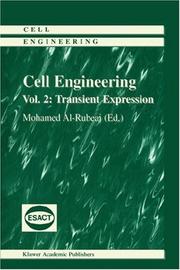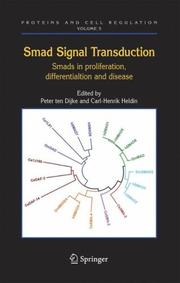| Listing 1 - 10 of 10 |
Sort by
|
Book
ISBN: 3319571273 3319571257 Year: 2017 Publisher: Cham : Springer International Publishing : Imprint: Springer,
Abstract | Keywords | Export | Availability | Bookmark
 Loading...
Loading...Choose an application
- Reference Manager
- EndNote
- RefWorks (Direct export to RefWorks)
This book critically evaluates the causal link between cell division machinery and disease. Further, it identifies key open questions in the field and the means for exploring them. Throughout the various chapters, internationally known contributors present the evidence for and against a causal link between key elements of the cell division machinery and diseases such as cancer, neuropathologies, aging, and infertility. A more clinically oriented chapter further discusses the current and future applications of anti-mitotic drugs in these diseases. Cell Division Machinery and Disease is essential reading for graduate or advanced graduate students, researchers or scientists working on cell division as well as clinicians interested in the molecular mechanisms of the discussed diseases.
Life sciences. --- Cancer research. --- Cell cycle. --- Cell physiology. --- Life Sciences. --- Cell Cycle Analysis. --- Cell Physiology. --- Cancer Research. --- Cell division. --- Cell proliferation. --- Cell renewal --- Cellular proliferation --- Division of cells --- Cell function --- Cytology --- Physiology --- Mitotic cycle --- Nuclear cycle (Cytology) --- Biological rhythms --- Cancer research --- Biosciences --- Sciences, Life --- Science --- Cell cycle --- Cell division --- Cell populations --- Cells --- Cell proliferation --- Growth --- Oncology. --- Tumors
Book
ISBN: 3642148158 9786612994517 3642148166 1282994514 Year: 2010 Publisher: Heidelberg : Springer,
Abstract | Keywords | Export | Availability | Bookmark
 Loading...
Loading...Choose an application
- Reference Manager
- EndNote
- RefWorks (Direct export to RefWorks)
From humble beginnings over 25 years ago as a lipid kinase activity associated with certain oncoproteins, PI3K (phosphoinositide 3-kinase) has been catapulted to the forefront of drug development in cancer, immunity and thrombosis, with the first clinical trials of PI3K pathway inhibitors now in progress. Here the authors give a brief overview of some key discoveries in the PI3K area and their impact, and include thoughts on the current state of the field, and where it could go from here.
Phosphoinositides. --- Cell proliferation. --- Cell death. --- Apoptosis. --- Cell renewal --- Cellular proliferation --- Phosphatidylinositides --- Phosphatidylinositol phosphates --- Medicine. --- Cancer research. --- Biomedicine. --- Cancer Research. --- Cancer research --- Clinical sciences --- Medical profession --- Human biology --- Life sciences --- Medical sciences --- Pathology --- Physicians --- Cell death --- Cell degeneration --- Cells --- Death (Biology) --- Cell cycle --- Cell division --- Cell populations --- Phospholipids --- Inositol --- Growth --- Oncology. --- Tumors
Book
ISBN: 1461425697 1441917705 144191773X 1441917691 1282828320 Year: 2010 Publisher: New York : Springer Science,
Abstract | Keywords | Export | Availability | Bookmark
 Loading...
Loading...Choose an application
- Reference Manager
- EndNote
- RefWorks (Direct export to RefWorks)
Modern studies of regulation of the cell division cycle were pioneered by Leland Hartwell, Paul Nurse, and Tim Hunt in yeast and marine invertebrates. This work identified proteins termed cyclins that fluxuate in abundance during progression through the cycle and partner with Cyclin dependent kinases (Cdks) to drive major cell cycle transitions. Much has been learned since about how these and other proteins control cell cycle progression in all eukaryotes, including man. Further research is uncovering how these controls are de-regulated in cancer, a disease of unbridled cell proliferation that is the leading cause of death in developed countries. However, there is much more to be learned, and the hard won gains are just beginning to impact cancer care. In 11 reviews by leading experts, this volume lays out the current state and directions of the field for biomedical scientists of all training levels. The collection begins with three reviews that delineate how cells initiate the cell cycle, from growth factor stimulation to activation of key transcription programs and origins of DNA replication. The next three reviews address issues of proliferation under duress, including how derangement of mitotic checkpoints can lead to cell death or genetic instability and how recycling of intracellular molecules (autophagy) is regulated. The next three reviews address the special context of long-term proliferation—how it is regulated in stem cells, how it can erode telomeric structures on the tips of chromosomes, and how it can culminate in senescence. The last two reviews describe how cell cycle advances are beginning to touch patients, in the characterization of pre-malignant states and in cancer therapy.
Cancer cells -- Proliferation. --- Cell proliferation. --- Cancer cells --- Cell proliferation --- Diseases --- Cell Growth Processes --- Cell Proliferation --- Neoplasms --- Growth --- Cell Physiological Processes --- Growth and Development --- Cell Physiological Phenomena --- Physiological Processes --- Phenomena and Processes --- Physiological Phenomena --- Medicine --- Oncology --- Health & Biological Sciences --- Proliferation --- Proliferation. --- Cell renewal --- Cellular proliferation --- Cancer cell proliferation --- Medicine. --- Cancer research. --- Pharmacology. --- Biomedicine. --- Cancer Research. --- Pharmacology/Toxicology. --- Cell cycle --- Cell division --- Cell populations --- Cells --- Oncology. --- Toxicology. --- Tumors --- Chemicals --- Pharmacology --- Poisoning --- Poisons --- Toxicology --- Drug effects --- Medical pharmacology --- Medical sciences --- Chemotherapy --- Drugs --- Pharmacy --- Cancer research --- Physiological effect
Book
ISBN: 3642136621 9786612971419 1282971417 364213663X Year: 2010 Publisher: New York : Springer,
Abstract | Keywords | Export | Availability | Bookmark
 Loading...
Loading...Choose an application
- Reference Manager
- EndNote
- RefWorks (Direct export to RefWorks)
From humble beginnings over 25 years ago as a lipid kinase activity associated with certain oncoproteins, PI3K (phosphoinositide 3-kinase) has been catapulted to the forefront of drug development in cancer, immunity and thrombosis, with the first clinical trials of PI3K pathway inhibitors now in progress. Here the authors give a brief overview of some key discoveries in the PI3K area and their impact, and include thoughts on the current state of the field, and where it could go from here.
Phosphoinositides. --- Cell proliferation. --- Cell death. --- Apoptosis. --- Phosphatidylinositides --- Phosphatidylinositol phosphates --- Cell renewal --- Cellular proliferation --- Medicine. --- Cancer research. --- Human physiology. --- Molecular biology. --- Biomedicine. --- Cancer Research. --- Human Physiology. --- Molecular Medicine. --- Molecular biochemistry --- Molecular biophysics --- Biochemistry --- Biophysics --- Biomolecules --- Systems biology --- Human biology --- Medical sciences --- Physiology --- Human body --- Cancer research --- Clinical sciences --- Medical profession --- Life sciences --- Pathology --- Physicians --- Cell death --- Cell degeneration --- Cells --- Death (Biology) --- Cell cycle --- Cell division --- Cell populations --- Phospholipids --- Inositol --- Growth --- Oncology. --- Tumors --- Health Workforce --- Cancer. --- Medicine --- Biology --- Cancer Biology. --- Biomedical Research. --- Research. --- Biological research --- Biomedical research --- Cancers --- Carcinoma --- Malignancy (Cancer) --- Malignant tumors

ISBN: 0585379718 0792357906 Year: 1999 Publisher: Dordrecht : Springer Netherlands : Imprint: Springer,
Abstract | Keywords | Export | Availability | Bookmark
 Loading...
Loading...Choose an application
- Reference Manager
- EndNote
- RefWorks (Direct export to RefWorks)
Integrating advances in molecular biology into bioprocesses presents a continuous challenge to scientists and bioengineers. This series is conceived to help meet this challenge. It examines and assesses the feasibility of new approaches for the modification of cellular function such as gene expression, protein processing, secretion, glycosylation, immortalisation, proliferation, and apoptosis as well as the systematic study of the metabolic genotype-phenotype relationship. The series provides detailed coverage of the methodology for improving cellular properties of cells used in the production of biopharmaceuticals, gene and cell therapies and tissue engineering. It also seeks to explain the cellular mechanisms underlying in vitro physiological activity and productivity. This volume, which is based on presentations at the `European Workshop on Animal Cell Engineering' held in Costa Brava, Spain, contains a collection of chapters relating to cellular function and modification by leading authorities in several different areas of basic research and the biopharmaceutical industry.
Animal cell biotechnology. --- Genetic engineering. --- Genetic regulation. --- Cell proliferation. --- Zoology. --- Biotechnology. --- Cytology. --- Morphology (Animals). --- Biomedical engineering. --- Pharmacy. --- Cell Biology. --- Animal Anatomy / Morphology / Histology. --- Biomedical Engineering and Bioengineering. --- Cell biology. --- Animal anatomy. --- Chemistry --- Medicine --- Drugs --- Materia medica --- Pharmacology --- Clinical engineering --- Medical engineering --- Bioengineering --- Biophysics --- Engineering --- Animal anatomy --- Animals --- Biology --- Physiology --- Cell biology --- Cellular biology --- Cells --- Chemical engineering --- Genetic engineering --- Natural history --- Anatomy --- Animal cells in biotechnology --- Animal biotechnology --- Cell renewal --- Cellular proliferation --- Cell cycle --- Cell division --- Cell populations --- Designed genetic change --- Engineering, Genetic --- Gene splicing --- Genetic intervention --- Genetic surgery --- Genetic recombination --- Biotechnology --- Transgenic organisms --- Gene expression --- Gene expression regulation --- Gene regulation --- Biosynthesis --- Cellular control mechanisms --- Molecular genetics --- Growth --- Regulation --- Anatomy, Comparative. --- Animal Anatomy.
Book
ISBN: 0883851156 0883851164 0883851008 0883851202 0883851288 0883851113 0883851121 9780883851203 9780883851289 9780883851005 Year: 1980 Volume: 15-16 Publisher: Place of publication unknown Mathematical Association of America
Abstract | Keywords | Export | Availability | Bookmark
 Loading...
Loading...Choose an application
- Reference Manager
- EndNote
- RefWorks (Direct export to RefWorks)
57.017.2 --- 57.087.1 --- 576.5 --- 574.3 --- #WPLT:dd.Prof.F.Symons --- 574.3 Populations and environment. Population dynamics --- Populations and environment. Population dynamics --- 576.5 Cell interactions. Intercellular junctions. Cell populations. Cell behaviour in culture --- Cell interactions. Intercellular junctions. Cell populations. Cell behaviour in culture --- 57.087.1 Biometry. Statistical study and treatment of biological data --- Biometry. Statistical study and treatment of biological data --- 57.017.2 Origin. Formation. Localization. Arrangement --- Origin. Formation. Localization. Arrangement --- Discrete mathematics --- Biomathematics. Biometry. Biostatistics --- Functional analysis --- Biology --- Biomathematics --- Biologie --- Biomathématiques --- Mathematical models --- Modèles mathématiques --- Graph theory --- Théorie des graphes --- Geometry, Algebraic --- Géométrie algébrique --- Mathematics --- Mathématiques --- History --- Histoire --- 512.7 --- 512.7 Algebraic geometry. Commutative rings and algebras --- Algebraic geometry. Commutative rings and algebras --- Algebraic geometry --- Geometry --- Biomathematics. --- Geometry, Algebraic. --- Graph theory. --- Mathematical models. --- History. --- Addresses, essays, lectures --- 519.1 --- 519.1 Combinatorics. Graph theory --- Combinatorics. Graph theory --- Géométrie algébrique --- Mathematics - History --- Biomathematique --- Methodes mathematiques --- Histoire des mathematiques --- 20e siecle

ISBN: 1280902485 9786610902484 1402047096 1402045425 9048171458 Year: 2006 Publisher: Dordrecht : Springer,
Abstract | Keywords | Export | Availability | Bookmark
 Loading...
Loading...Choose an application
- Reference Manager
- EndNote
- RefWorks (Direct export to RefWorks)
For the first time world-leading experts in the area of cellular signaling have joined to the production of a book on Smad signal transduction. Smads are the principal intracellular effectors of TGF-b family members that control numerous cellular responses with critical roles in development and in tissue homeostasis. In a series of 22 cutting-edge chapters forward looking reviews of Smads are provided that cover their discovery, evolution, role in development, mechanism of action and regulation, and how deregulation in Smad signalling contributes to human diseases. Written for an audience with basic understanding of molecular and cell biology, this volume provides an in-depth review of a rapidly developing field and extensive cross-references between chapters are provided. This book will be of particular interest to basic and applied biomedical researchers (students, post-docs or group leaders) with desire to understand the principles of cell-cell communication and mechanisms by which signaling pathways and gene programs control cell proliferation and differentiation, and how this knowledge may come to be applied in the clinic.
Cellular signal transduction. --- Transforming growth factors-beta. --- Cell proliferation. --- Cell differentiation. --- Life sciences. --- Cancer research. --- Molecular biology. --- Biochemistry. --- Cell biology. --- Developmental biology. --- Life Sciences. --- Life Sciences, general. --- Molecular Medicine. --- Cancer Research. --- Biochemistry, general. --- Cell Biology. --- Developmental Biology. --- Development (Biology) --- Biology --- Growth --- Ontogeny --- Cell biology --- Cellular biology --- Cells --- Cytologists --- Biological chemistry --- Chemical composition of organisms --- Organisms --- Physiological chemistry --- Chemistry --- Medical sciences --- Molecular biochemistry --- Molecular biophysics --- Biochemistry --- Biophysics --- Biomolecules --- Systems biology --- Cancer research --- Biosciences --- Sciences, Life --- Science --- Composition --- Cell fate specification --- Cell specification --- Differentiation of cells --- Fate specification of cells --- Specification of cells --- Morphogenesis --- Cell renewal --- Cellular proliferation --- Cell cycle --- Cell division --- Cell populations --- Beta transforming growth factors --- TGF-beta (Peptide) --- Transforming growth factor beta --- Transforming growth factors --- Cellular information transduction --- Information transduction, Cellular --- Signal transduction, Cellular --- Bioenergetics --- Cellular control mechanisms --- Information theory in biology --- Differentiation --- Fate specification --- Specification --- Medicine. --- Oncology. --- Cytology. --- Clinical sciences --- Medical profession --- Human biology --- Life sciences --- Pathology --- Physicians --- Tumors --- Health Workforce

ISBN: 0879691115 9780879691110 Year: 1974 Volume: v. 1 Publisher: New York, N.Y. Cold Spring Harbor Laboratory
Abstract | Keywords | Export | Availability | Bookmark
 Loading...
Loading...Choose an application
- Reference Manager
- EndNote
- RefWorks (Direct export to RefWorks)
Zoohistology. Zoocytology --- Cell proliferation --- Cellular control mechanisms --- Cellules --- Régulation cellulaire --- Congresses --- Prolifération --- Congrès --- Cell Division. --- Cell Transformation, Neoplastic. --- -Cellular control mechanisms --- -Cell regulation --- Biological control systems --- Cell metabolism --- Cell renewal --- Cellular proliferation --- Cell cycle --- Cell division --- Cell populations --- Cells --- Neoplastic Cell Transformation --- Transformation, Neoplastic Cell --- Tumorigenic Transformation --- Neoplastic Transformation, Cell --- Cell Neoplastic Transformation --- Cell Neoplastic Transformations --- Cell Transformations, Neoplastic --- Neoplastic Cell Transformations --- Neoplastic Transformations, Cell --- Transformation, Cell Neoplastic --- Transformation, Tumorigenic --- Transformations, Cell Neoplastic --- Transformations, Neoplastic Cell --- Transformations, Tumorigenic --- Tumorigenic Transformations --- Cell Line, Transformed --- Cell Division Phase --- Cell Divisions --- M Phase --- Division Phase, Cell --- Division, Cell --- Divisions, Cell --- M Phases --- Phase, Cell Division --- Phase, M --- Phases, M --- Cleavage Stage, Ovum --- Growth --- Congresses. --- -Congresses --- -Neoplastic Cell Transformation --- Cell regulation --- Régulation cellulaire --- Prolifération --- Congrès --- Cell Division --- Cell Transformation, Neoplastic --- Cell proliferation - Congresses --- Cellular control mechanisms - Congresses
Periodical
ISSN: 09607722 13652184 Publisher: Oxford
Abstract | Keywords | Export | Availability | Bookmark
 Loading...
Loading...Choose an application
- Reference Manager
- EndNote
- RefWorks (Direct export to RefWorks)
Histology. Cytology --- Genetics --- Cell proliferation --- Cells --- Molecular biology --- Tissue metabolism --- Cell Cycle --- Cell Differentiation --- Cellules --- Biologie moléculaire --- Tissus (Histologie) --- Periodicals --- periodicals --- Prolifération --- Périodiques --- Métabolisme --- Cell cycle --- Cell Cycle. --- Cell Differentiation. --- Societies, Medical. --- Cell cycle. --- Cell proliferation. --- Prolifération cellulaire. --- Différenciation cellulaire. --- Cycle cellulaire. --- Cell Division. --- Histology. --- Cell Biology. --- Cellular Biology --- Cytology --- Biologies, Cell --- Biologies, Cellular --- Biology, Cell --- Biology, Cellular --- Cell Biologies --- Cellular Biologies --- Cell Division Phase --- Cell Divisions --- M Phase --- Division Phase, Cell --- Division, Cell --- Divisions, Cell --- M Phases --- Phase, Cell Division --- Phase, M --- Phases, M --- Cleavage Stage, Ovum --- Information Technology --- Life Sciences --- Modelling & Simulation --- Biology --- Cytology, Cell Biology --- Micro and Molecular Biology --- Biologie moléculaire --- Prolifération --- Périodiques --- Métabolisme --- EBSCOASP-E EJBIOLO EJBIOMO EJMEDEC EPUB-ALPHA-C EPUB-PER-FT MDCYTOLO WILEY-E --- Cell Division --- Histology --- Cell Biology --- periodicals. --- MDCYTOLO --- stem cells --- regenerative medicine --- tissue engineering --- cell biology --- cell proliferation --- cancer --- Cell renewal --- Cellular proliferation --- Cell division --- Cell populations --- Mitotic cycle --- Nuclear cycle (Cytology) --- Biological rhythms --- Cell Division Cycle --- Cell Cycles --- Cell Division Cycles --- Cycle, Cell --- Cycle, Cell Division --- Cycles, Cell --- Cycles, Cell Division --- Division Cycle, Cell --- Division Cycles, Cell --- Cell Cycle Proteins --- Genes, cdc --- Medical Societies --- Medical Society --- Society, Medical --- Differentiation, Cell --- Cell Differentiations --- Differentiations, Cell --- Embryo, Mammalian --- Gene Expression Regulation --- Cell Lineage --- Growth --- Oncology. Neoplasms --- Periodicals. --- Cycle cellulaire --- Cytologie --- Celcyclus. --- Celdifferentiatie. --- Différenciation

ISBN: 9783540743286 9783540238584 9783540254393 9783540291626 3540238581 3540254390 3540291628 3540743286 3540315446 3540314385 3540743316 3540324151 Year: 2008 Volume: 1867 Publisher: Berlin Springer
Abstract | Keywords | Export | Availability | Bookmark
 Loading...
Loading...Choose an application
- Reference Manager
- EndNote
- RefWorks (Direct export to RefWorks)
This volume introduces some basic mathematical models for cell cycle, proliferation, cancer, and cancer therapy. Chapter 1 gives an overview of the modeling of the cell division cycle. Chapter 2 describes how tumor secretes growth factors to form new blood vessels in its vicinity, which provide it with nutrients it needs in order to grow. Chapter 3 explores the process that enables the tumor to invade the neighboring tissue. Chapter 4 models the interaction between a tumor and the immune system. Chapter 5 is concerned with chemotherapy; it uses concepts from control theory to minimize obstacles arising from drug resistance and from cell cycle dynamics. Finally, Chapter 6 reviews mathematical results for various cancer models.
51-7 --- 51:37 --- 51:37 Mathematics-:-Opvoeding en onderwijs --(algemeen) --- Mathematics-:-Opvoeding en onderwijs --(algemeen) --- 51-7 Mathematical studies and methods in other sciences. Scientific mathematics. Actuarial mathematics. Biometrics. Econometrics etc. --- Mathematical studies and methods in other sciences. Scientific mathematics. Actuarial mathematics. Biometrics. Econometrics etc. --- Neurosciences informatiques --- Differential Equations. --- Mathematical Biology in General. --- Ordinary Differential Equations. --- Computational Mathematics and Numerical Analysis. --- Computer Appl. in Life Sciences. --- Models, Neurological --- Nerve Net --- Mathematical Modeling and Industrial Mathematics. --- Muscle Contraction --- Musculoskeletal Physiological Processes --- Musculoskeletal Physiological Phenomena --- Experimental Model --- Experimental Models --- Mathematical Model --- Model, Experimental --- Models (Theoretical) --- Models, Experimental --- Models, Theoretic --- Theoretical Study --- Mathematical Models --- Model (Theoretical) --- Model, Mathematical --- Model, Theoretical --- Studies, Theoretical --- Study, Theoretical --- Theoretical Model --- Theoretical Models --- Theoretical Studies --- Nervous Systems --- System, Nervous --- Systems, Nervous --- Computer mathematics --- Metabolic Phenomenon --- Metabolic Process --- Metabolism Concepts --- Metabolism Phenomena --- Process, Metabolic --- Processes, Metabolic --- Anabolism --- Catabolism --- Metabolic Concepts --- Metabolic Processes --- Concept, Metabolic --- Concept, Metabolism --- Concepts, Metabolic --- Concepts, Metabolism --- Metabolic Concept --- Metabolism Concept --- Phenomena, Metabolic --- Phenomena, Metabolism --- Phenomenon, Metabolic --- Musculoskeletal Physiologic Process --- Musculoskeletal Physiological Concepts --- Musculoskeletal Physiological Phenomenon --- Physiology, Musculoskeletal --- Musculoskeletal Physiologic Processes --- Musculoskeletal Physiological Process --- Musculoskeletal Physiology --- Concept, Musculoskeletal Physiological --- Concepts, Musculoskeletal Physiological --- Musculoskeletal Physiological Concept --- Phenomena, Musculoskeletal Physiological --- Phenomenon, Musculoskeletal Physiological --- Physiologic Process, Musculoskeletal --- Physiologic Processes, Musculoskeletal --- Process, Musculoskeletal Physiologic --- Process, Musculoskeletal Physiological --- Processes, Musculoskeletal Physiologic --- Processes, Musculoskeletal Physiological --- Active Ion Transport --- Facilitated Ion Transport --- Passive Ion Transport --- Antiport --- Ion Cotransport --- Ion Exchange, Intracellular --- Symport --- Uniport --- Cotransport, Ion --- Exchange, Intracellular Ion --- Intracellular Ion Exchange --- Ion Transport, Active --- Ion Transport, Facilitated --- Ion Transport, Passive --- Transport, Active Ion --- Transport, Ion --- Second Messengers --- Intracellular Second Messengers --- Intracellular Second Messenger --- Messenger, Second --- Messengers, Intracellular Second --- Messengers, Second --- Second Messenger --- Second Messenger System --- Second Messenger, Intracellular --- Second Messengers, Intracellular --- System, Second Messenger --- Systems, Second Messenger --- Calcium Puffs --- Calcium Sparks --- Calcium Spikes --- Calcium Oscillations --- Calcium Waves --- Calcium Oscillation --- Calcium Puff --- Calcium Signalings --- Calcium Spark --- Calcium Spike --- Calcium Wave --- Oscillation, Calcium --- Oscillations, Calcium --- Puff, Calcium --- Puffs, Calcium --- Signaling, Calcium --- Signalings, Calcium --- Spark, Calcium --- Sparks, Calcium --- Spike, Calcium --- Spikes, Calcium --- Wave, Calcium --- Waves, Calcium --- Muscular Contraction --- Inotropism --- Contraction, Muscle --- Contraction, Muscular --- Contractions, Muscle --- Contractions, Muscular --- Inotropisms --- Muscle Contractions --- Muscular Contractions --- Calculus of Variations and Optimal Control; Optimization. --- Physiological, Cellular and Medical Topics. --- Cell Cycle --- Processes, Cell Growth --- Cell Division Cycle --- Cell Cycles --- Cell Division Cycles --- Cycle, Cell --- Cycle, Cell Division --- Cycles, Cell --- Cycles, Cell Division --- Division Cycle, Cell --- Division Cycles, Cell --- Cell Multiplication --- Cell Number Growth --- Cell Growth in Number --- Cellular Proliferation --- Growth, Cell Number --- Multiplication, Cell --- Number Growth, Cell --- Proliferation, Cell --- Proliferation, Cellular --- Mathematics. --- Cell biology. --- Mathematical models. --- Biomathematics. --- Mathematical and Computational Biology. --- Cell Biology. --- Differential equations. --- Partial differential equations. --- Calculus of variations. --- Partial Differential Equations. --- Bioinformatics. --- Computational biology. --- Neurobiology. --- Computer mathematics. --- Ecology --- Evolution (Biology) --- Phylogeny --- Population genetics --- Animal phylogeny --- Animals --- Phylogenetics --- Phylogeny (Zoology) --- Biology --- Mathematical models --- Mathematical studies and methods in other sciences. Scientific mathematics. Actuarial mathematics. Biometrics. Econometrics etc --- Math --- Science --- Mathematics --- Models, Mathematical --- Simulation methods --- Cell biology --- Cellular biology --- Cells --- Cytologists --- Neurosciences --- Discrete mathematics --- Electronic data processing --- Partial differential equations --- 517.91 Differential equations --- Differential equations --- Bioinformatics --- Bio-informatics --- Biological informatics --- Information science --- Computational biology --- Systems biology --- Data processing --- Isoperimetrical problems --- Variations, Calculus of --- Maxima and minima --- Cellular signal transduction. --- Calcium --- Physiological effect. --- Computational neuroscience. --- Differential equations, partial. --- Mathematical optimization. --- Physiology --- Computer science --- Data processing. --- Cytology. --- Animal physiology --- Anatomy --- Optimization (Mathematics) --- Optimization techniques --- Optimization theory --- Systems optimization --- Mathematical analysis --- Operations research --- System analysis --- Cell proliferation. --- Cell cycle. --- Cancer cells. --- Pathology, Cellular --- Mitotic cycle --- Nuclear cycle (Cytology) --- Biological rhythms --- Cell renewal --- Cellular proliferation --- Cell cycle --- Cell division --- Cell populations --- Growth --- Neural circuitry --- Auditory pathways. --- Cellular signal transduction --- Physiological transport --- Physiological effect --- Metabolism --- Bioinformatics . --- Computational biology . --- Calcium - Physiological effect.
| Listing 1 - 10 of 10 |
Sort by
|

 Search
Search Feedback
Feedback About UniCat
About UniCat  Help
Help News
News